Two Stories About Flying summary

Chapter 3 of the Class 10 English textbook First Flight includes two inspiring stories: “His First Flight” by Liam O’Flaherty and “The Black Aeroplane” by Frederick Forsyth. Both stories explore themes of fear, courage, and mystery, helping students understand how challenges lead to growth. Two Stories About Flying summary Story 1: His First Flight – Liam O’Flaherty A young seagull is afraid to fly. His siblings have already taken flight, but he hesitates, fearing he’ll fall. His parents encourage him, even threaten to leave him hungry. Finally, driven by hunger and instinct, he jumps—and discovers the joy of flying. Key Message: Fear is natural, but courage leads to freedom. Story 2: The Black Aeroplane – Frederick Forsyth A young pilot flies his Dakota aircraft at night, heading to England. Suddenly, he faces a violent storm and loses contact with air control. Just when hope fades, a mysterious black aeroplane appears and guides him safely to the runway. After landing, he’s shocked to learn no other plane was in the sky. Key Message: Help can come from unexpected—and unexplained—sources. Exam-Ready Highlights Chapter Name: Two Stories About Flying Book: First Flight (Class 10 English) Authors: Liam O’Flaherty & Frederick Forsyth Themes: Courage, mystery, self-belief Literary Devices: Imagery, suspense, symbolism Moral Lessons: Trust yourself, face challenges, believe in possibilities What is the summary of Two Stories About Flying Class 10? It includes two stories: His First Flight, where a young seagull overcomes fear and learns to fly, and The Black Aeroplane, where a pilot is mysteriously guided to safety during a storm. Both stories highlight courage and unexpected help. FAQs – Two Stories About Flying Q1. What is the theme of ‘His First Flight’? → Overcoming fear and gaining confidence through experience. Q2. Why is ‘The Black Aeroplane’ mysterious? → The pilot is saved by an unknown aircraft that no one else saw or tracked. Q3. What do both stories teach us? → Courage leads to growth, and sometimes help arrives in unexpected ways. Q4. Who are the authors of these stories? → Liam O’Flaherty (His First Flight) and Frederick Forsyth (The Black Aeroplane). Q5. Why is this chapter important for Class 10 exams? → It builds emotional intelligence, critical thinking, and narrative analysis skills. Why EaseEdu Content Ranks Better At EaseEdu, we create SEO-rich academic content that helps students learn faster and helps schools rank higher on Google. Our summaries are: Clear and exam-focused Optimized for search intent Packed with FAQs and key points Trusted by schools and coaching centers Summary of Nelson Mandela Class 10 A Letter to God Summary How to Learn Sanskrit Partner with EaseEdu EaseEdu is your growth partner in education. We help schools and institutes deliver high-quality content that ranks, converts, and supports student success.
Summary of Nelson Mandela Class 10
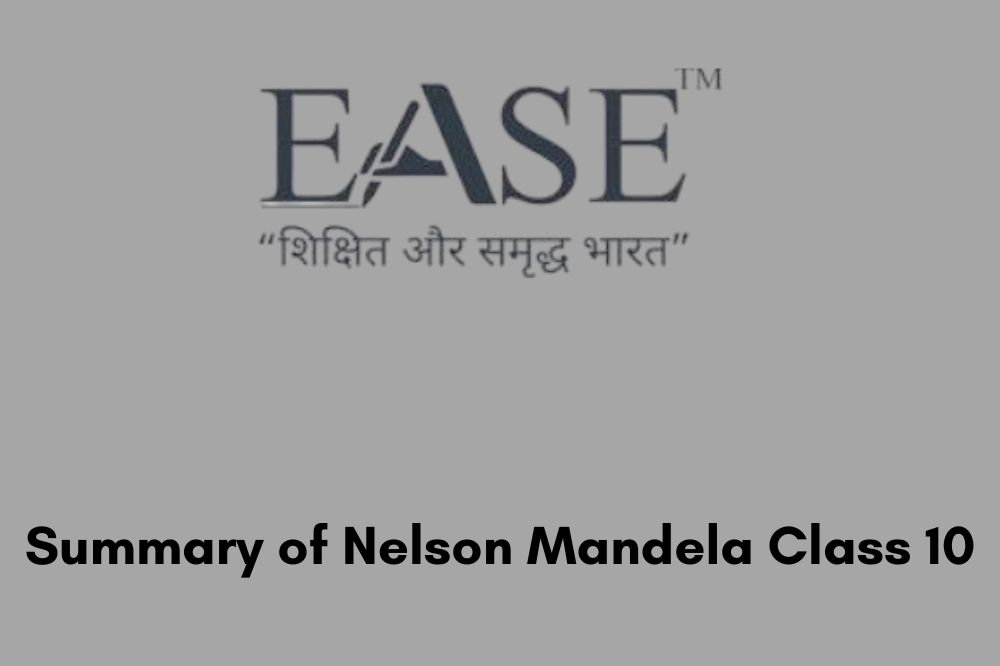
Nelson Mandela: Long Walk to Freedom – Class 10 Summary Chapter Overview: This chapter is an extract from Nelson Mandela’s autobiography Long Walk to Freedom. It captures the historic moment when Mandela became the first Black President of South Africa on 10th May 1994, marking the end of apartheid and the beginning of a democratic nation. Summary of Nelson Mandela Class 10? The chapter opens with the inauguration ceremony at the Union Buildings in Pretoria, attended by global leaders. Mandela reflects on the long struggle against apartheid—a system of racial segregation that oppressed Black South Africans for centuries. He recalls the sacrifices made by countless freedom fighters like Oliver Tambo, Walter Sisulu, and Chief Luthuli, who fought for justice, equality, and human dignity. Mandela emphasizes that no one is born hating another person; hatred is taught, and therefore, love can be taught too. The day is symbolic: two national anthems are sung—‘Nkosi Sikelel’ by the Black community and ‘Die Stem’ by the white population—representing unity and reconciliation. Mandela pledges to build a nation free from poverty, discrimination, and injustice. He believes that freedom is not just the absence of oppression, but the ability to live with dignity and equality. The chapter ends with Mandela’s powerful message: true freedom means liberating both the oppressed and the oppressor. Key Themes Freedom and Equality Sacrifice and Courage Unity in Diversity Forgiveness and Reconciliation Exam-Focused Points Author: Nelson Rolihlahla Mandela Genre: Autobiography Setting: Union Buildings, Pretoria, South Africa Date of Inauguration: 10th May 1994 Message: End of apartheid, beginning of democracy Literary Devices: Metaphor, symbolism, repetition A Letter to God Summary How to Learn Sanskrit class 10 sanskrit chapter 1 question answer FAQs – Nelson Mandela Chapter Q1. What is the main idea of the chapter? → The chapter highlights Mandela’s journey from oppression to freedom and his vision for a united South Africa. Q2. Why is 10th May 1994 significant? → It marks the day Nelson Mandela became South Africa’s first Black President. Q3. What does Mandela say about hatred and love? → He says people are taught to hate, but love comes more naturally to the human heart. Q4. What is apartheid? → A system of racial segregation that denied basic rights to Black South Africans. Q5. What does Mandela mean by “freedom”? → Freedom means equality, dignity, and the ability to live without fear or discrimination. Grow Your School or Institute with EaseEdu EaseEdu helps schools and coaching centers deliver exam-ready content, SEO-rich blogs, and digital visibility. Collaborate with us to: Boost your academic brand Provide students with high-quality study material Rank on Google for key education queries Partner with EaseEdu—your growth ally in modern education.
A Letter to God Summary – Class 10 English Chapter 1 | EaseEdu
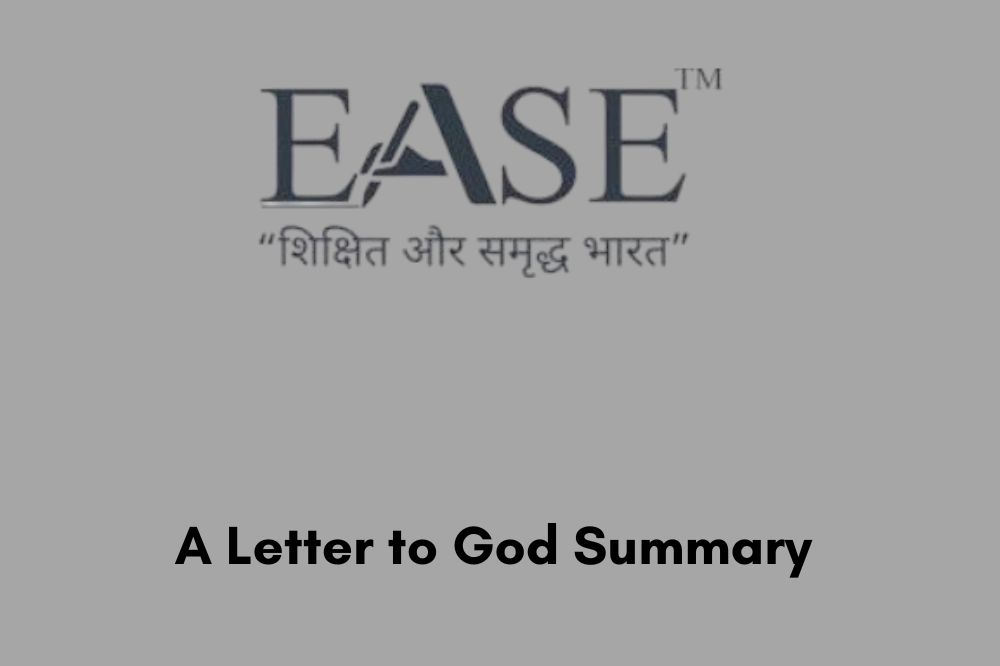
“A Letter to God” is the first chapter in the Class 10 English textbook First Flight, written by Gregorio López y Fuentes, a Mexican author known for portraying rural life and human emotions. This heart-touching story revolves around Lencho, a poor farmer whose unwavering faith in God becomes the central theme. A Letter to God Summary? Lencho lives in a small house on a hill and depends entirely on his crops for survival. One year, he eagerly awaits rain to nourish his fields. The rain arrives—but turns into a destructive hailstorm, ruining his entire harvest. Despite the devastation, Lencho’s faith in God remains unshaken. He writes a letter to God, asking for 100 pesos to replant his crops and support his family. He posts the letter, believing God will respond. The postmaster, moved by Lencho’s innocence and belief, collects money from his colleagues and sends 70 pesos anonymously to Lencho. However, Lencho becomes angry, convinced that God would never send less than he asked for. He writes another letter to God, asking for the remaining amount—and requests that it not be sent through the post office, accusing the employees of theft. Key Themes : A Letter to God Summary Faith vs. Reality – Lencho’s blind trust in divine help contrasts with the irony of human kindness. Innocence and Simplicity – Lencho’s character reflects purity and emotional depth. Human Compassion – The postmaster’s gesture shows that kindness exists, even if misunderstood. Why This Chapter Matters This story is a powerful lesson in hope, belief, and irony. It teaches students to appreciate the value of empathy, while also understanding how perspective shapes interpretation. EaseEdu recommends this chapter for building critical thinking, moral reasoning, and exam-ready writing skills. Grow Your School or Institute with EaseEdu Partner with EaseEdu to boost your academic visibility, deliver high-quality study content, and engage students with SEO-rich, exam-ready resources. From chapter summaries to digital campaigns, we help schools and coaching centers stand out online and offline. 📈 Collaborate with us to elevate your brand, empower your students, and expand your reach. Boost your school’s online visibility Provide students free content. Create customized study material for Class 6–12th. Contact us to partner and grow your academic brand with EaseEdu. FAQs – A Letter to God (Class 10) Q1. Who wrote “A Letter to God”? → Gregorio López y Fuentes, a Mexican author. Q2. What is the main message of the story? → The story highlights unwavering faith, human kindness, and the irony of perception. Q3. Why did Lencho write a letter to God? → He wanted financial help (100 pesos) after his crops were destroyed by hail. Q4. How did the postmaster respond to Lencho’s letter? → He collected money from his staff and sent 70 pesos anonymously to support Lencho. Q5. Why was Lencho angry after receiving the money? → He believed God sent the full amount and accused the post office employees of stealing the rest. class 10 sanskrit chapter 1 question answer CBSE Class 10 Date Sheet 2026 Surdas ke Pad Class 10 Hindi Chapter 1 CBSE Class 10 SST Syllabus 2025-26 Conclusion: A Letter to God Summary “A Letter to God” is more than just a story—it’s a reflection of faith, irony, and human emotion. For Class 10 students, this chapter is a gateway to understanding literary depth and moral values. EaseEdu is proud to support learners with clear summaries, exam tools, and school collaborations that make education accessible and impactful. Join EaseEdu. Simplify learning. Amplify results.
Class 8 Sanskrit Chapter 5 Question Answer
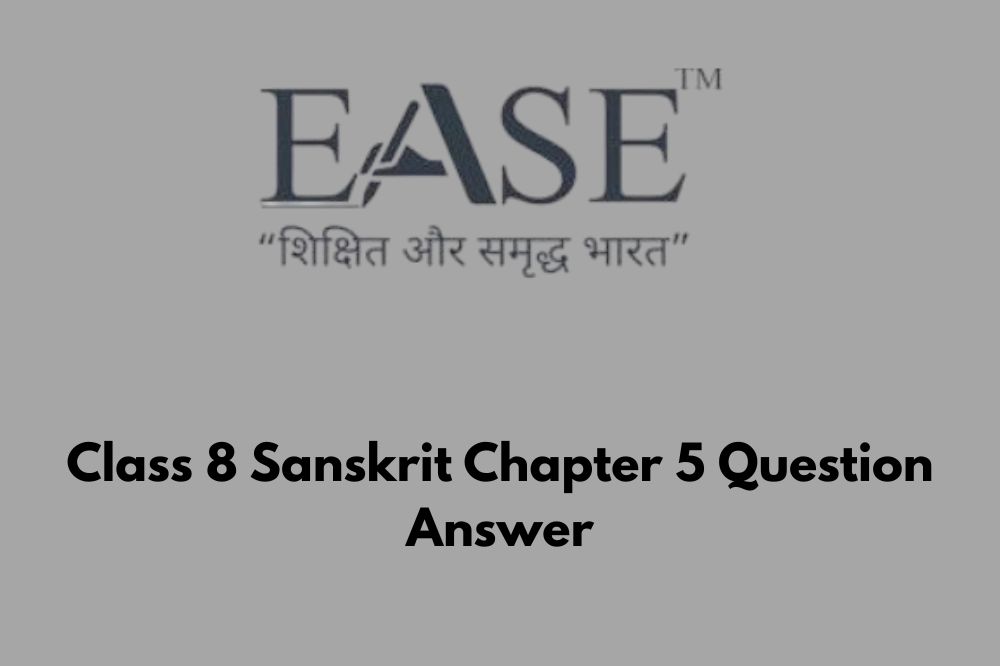
Class 8 Sanskrit Chapter 5 Question Answer – गीता सुगीता कर्तव्या | अभ्यासात् जायते सिद्धिः Class 8 Sanskrit Chapter 5, titled गीता सुगीता कर्तव्या, introduces students to the timeless wisdom of the श्रीमद्भगवद्गीता. Through dialogues between श्रीकृष्ण and अर्जुन, this chapter teaches values like duty, self-control, and inner peace. The exercises in this lesson help students understand Sanskrit grammar, vocabulary, and spiritual concepts in a simple, exam-oriented format. This blog post provides complete question answers, extra questions, and FAQs to help students revise and score well. अभ्यासात् जायते सिद्धिः – प्रश्न उत्तर (पृष्ठ 57–59) 1. एकपदेन उत्तरं लिखत (One-word answers) श्रद्धावान् जनः किं लभते? → ज्ञानं कस्मात् सम्मोहः जायते? → स्मृतिविभ्रमः सम्मोहात् किं जायते? → बुद्धिनाशः अर्जुनाय गीतां कः उपदिष्टवान्? → श्रीकृष्णः हर्षामर्षभयोद्वेगैः मुक्तः नरः कस्य प्रियः भवति? → श्रीकृष्णः 2. पूर्णवाक्येन उत्तरं लिखत (Full-sentence answers) वाङ्मयं तपः कीदृशं वाक्यं उच्यते? → अनुद्वेगकरं सत्यं प्रियं च हितं वाक्यं, स्वाध्याय अभ्यसनं च वाङ्मयं तपः उच्यते। स्थितधीः जनः कीदृशः भवति? → दुःखेषु अनुद्विग्नमनाः, सुखेषु विगतस्पृहा, वीतराग-भय-क्रोधः जनः स्थितधीः उच्यते। जनः कथं प्रणश्यति? → जनः बुद्धिनाशात् प्रणश्यति। उत्तमां शान्तिं जनः कथं प्राप्नोति? → श्रद्धावान् संयतेन्द्रियः जनः ज्ञानं लब्ध्वा उत्तमां शान्तिं प्राप्नोति। उपदेशप्राप्तये त्रयः उपायाः के भवन्ति? → अभिवादनशीलता, सेवा, जिज्ञासा च। 3. कोष्ठकस्थ पदानि उपयुज्य वाक्यानि रचयत वाङ्मयं → अनुद्वेगकरं सत्यं प्रियहितं च वाक्यं वाङ्मयं तपः उच्यते। स्थितधीः → सततं सन्तुष्टः दृढनिश्चयः च स्थितधीः भवति। योगी → अनुद्विग्नमनाः मुनिः योगी उच्यते। सेवया → तद् आत्मज्ञानं प्रणिपातेन परिप्रश्नेन सेवया च विद्धि। स्मृतिविभ्रमः → सम्मोहात् स्मृतिविभ्रमः भवति। 4. पदानि उपयुज्य वाक्यानि रचयत उच्यते → अहिंसा परमो धर्मः इति महाभारते उच्यते। च → रामः, सीता लक्ष्मणः च वनम् अगच्छन्। न → असत्यं न वदेत्। लब्ध्वा → ज्ञानं लब्ध्वा नरः ज्ञानचक्षु प्राप्नोति। कुर्यात् → छात्रः ध्यानेन अध्ययनं कुर्यात्। 5. श्लोक पूर्ति श्रद्धावाँल्लभते ज्ञानं तत्परः → संयतेन्द्रियः ____________ चैव वाङ्मयं तप उच्यते → स्वाध्यायाभ्यसनं सन्तुष्टः सततं योगी यतात्मा → दृढ़निश्चयः ____________ भवति सम्मोहः → क्रोधात् तद्विद्धि ____________ परिप्रश्नेन सेवया → प्रणिपातेन 6. स्त्रीलिङ्ग रूपान्तरण गुणवान् → गुणवती आयुष्मान् → आयुष्मती क्षमावान् → क्षमावती ज्ञानवान् → ज्ञानवती श्रीमान् → श्रीमती 7. स्तम्भ मिलान अ पद इ पद सर्वभूतानाम् सर्वेषां प्राणिनाम् अनुद्विग्नमनाः यस्य मनः विचलितं न भवति स्थितधीः स्थिरमतिमान् परिप्रश्नेन पुनः पुनः प्रश्नकरणेन संयतेन्द्रियः इन्द्रियसंयमी श्रीमद्भगवद्गीता – संक्षिप्त परिचय श्रीमद्भगवद्गीता महाभारत के भीष्मपर्व का भाग है। इसमें 18 अध्याय और 700 श्लोक हैं। यह अर्जुन और श्रीकृष्ण के संवाद पर आधारित है। गीता जीवन, धर्म, आत्मा और मोक्ष के विषयों पर प्रकाश डालती है। यह भारत का पवित्रतम ग्रंथ माना जाता है। follow us on Instragram FAQs – Class 8 Sanskrit Chapter 5 Q1. गीता सुगीता कर्तव्या का क्या अर्थ है? → गीता को अच्छे ढंग से पढ़ना और जीवन में अपनाना चाहिए। Q2. श्रीमद्भगवद्गीता किसने अर्जुन को उपदेश दी? → भगवान श्रीकृष्ण ने। Q3. इस पाठ में कितने श्लोक हैं? → कुल 8 श्लोक हैं। Q4. ‘स्थितधीः’ किसे कहते हैं? → जो सुख-दुःख में सम रहता है, राग-क्रोध से मुक्त होता है। Q5. यह पाठ परीक्षा के लिए क्यों महत्वपूर्ण है? → इसमें संस्कृत भाषा, व्याकरण, जीवन मूल्य और श्लोकों का अभ्यास एक साथ मिलता है। How to Learn Sanskrit Class 8th Sanskrit Chapter 5 Hindi Translation Conclusion – अभ्यास से ही सिद्धि मिलती है Class 8 Sanskrit Chapter 5 – गीता सुगीता कर्तव्या न केवल भाषा का अभ्यास कराता है, बल्कि जीवन के गहरे मूल्यों को भी सिखाता है। EaseEdu के इस ब्लॉग में दिए गए प्रश्न उत्तर, व्याकरण अभ्यास और FAQs छात्रों को परीक्षा में आत्मविश्वास और सफलता दिलाने में मदद करेंगे। गीता का अभ्यास करें, जीवन को श्रेष्ठ बनाएं।
Class 8th Sanskrit Chapter 5 Hindi Translation
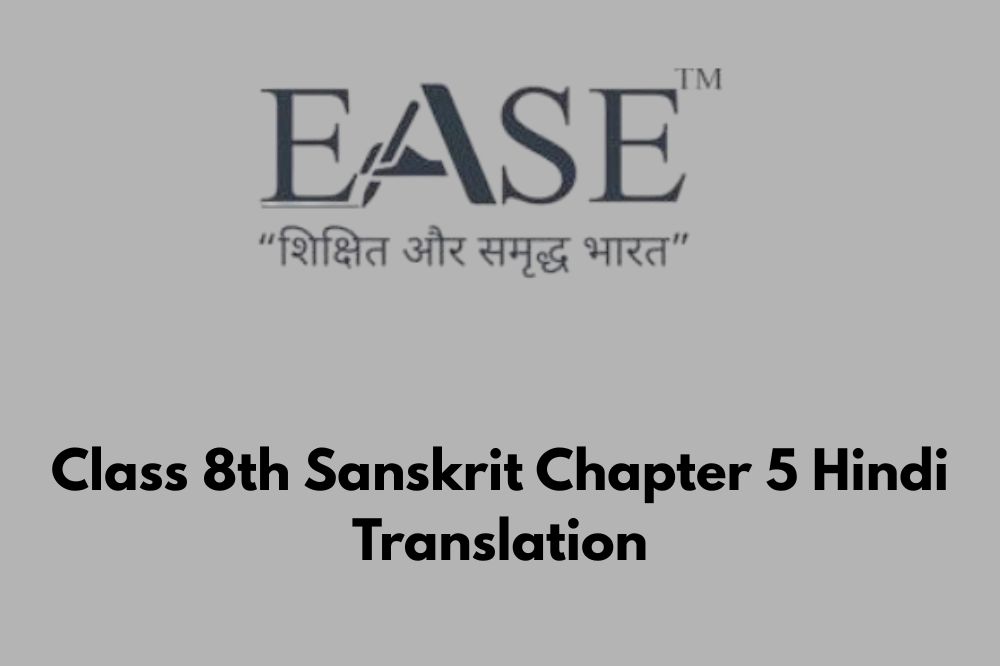
परिचय – गीता सुगीता कर्तव्या क्या है? गीता सुगीता कर्तव्या कक्षा 8 संस्कृत पाठ्यपुस्तक का पाँचवाँ अध्याय है, जिसमें श्रीमद्भगवद्गीता के महत्व को सरल भाषा में समझाया गया है। यह पाठ न केवल धार्मिक दृष्टि से महत्वपूर्ण है, बल्कि छात्रों को जीवन के मूल्यों, कर्तव्य और आत्म-नियंत्रण की शिक्षा भी देता है। EaseEdu आपके लिए लाया है इस अध्याय का पूरा हिंदी अनुवाद, व्याकरणिक विश्लेषण और परीक्षा उपयोगी शब्दार्थ। कक्षा 8 संस्कृत – अध्याय 5: गीता सुगीता कर्तव्या श्लोक, पदच्छेद और हिंदी अनुवाद | EaseEdu हिंदी समाधान (क) संस्कृत मूलपाठ: कुरुक्षेत्रे श्रीगीता – जयन्ती – महोत्सवः आचरितः। तत्र बहवः जनाः अगच्छन् । रमेशः अपि स्वजनकेन सह तत्र गतवान्। कथावाचक : गीतायाः विषये वर्णयति स्म – गीता सुगीता कर्तव्या किमन्यैः शास्त्रविस्तरैः । या स्वयं पद्मनाभस्य मुखपद्माद्विनिःसृता ॥ पदच्छेद: गीता सुगीता कर्तव्या, किम् अन्यैः शास्त्रविस्तरैः, या स्वयं पद्मनाभस्य मुखपद्मात् विनिःसृता। हिंदी अनुवाद: गीता को अच्छे ढंग से पढ़ना चाहिए, अन्य ग्रंथों की आवश्यकता नहीं है। यह स्वयं भगवान पद्मनाभ (विष्णु) के मुख से निकली है। class 10 sanskrit chapter 1 question answer How to Learn Sanskrit (ख) संस्कृत मूलपाठ: इदं श्रुत्वा रमेशः पितरम् अपृच्छत् – “पितः ! गीता का ? कथं सुगीता कर्तव्या?” पिता – पुत्र! बहुभ्यः वर्षेभ्यः पूर्वं कुरुक्षेत्रे कौरवाणां पाण्डवानां च मध्ये सङ्ग्रामः अभवत्। तस्मिन् युद्धे स्वबान्धवान् दृष्ट्वा अर्जुन : युद्धं कर्तुं न इच्छति स्म। तदा भगवान् श्रीकृष्णः युद्धपराङ्मुखम् अर्जुनं कर्तव्यपालनार्थम् उपदिष्टवान् । श्रीकृष्णस्य उपदेश: एव श्रीमद्भगवद्गीता अस्ति। गीतायाम् अमृततुल्याः उपदेशाः सन्ति । हिंदी अनुवाद: यह सुनकर रमेश ने अपने पिता से पूछा – “पिताजी! गीता क्या है? इसे अच्छे से क्यों पढ़ना चाहिए?” पिता ने उत्तर दिया – “बेटा! बहुत वर्षों पहले कुरुक्षेत्र में कौरवों और पांडवों के बीच युद्ध हुआ था। उस युद्ध में अपने संबंधियों को देखकर अर्जुन युद्ध करने को तैयार नहीं था। तब भगवान श्रीकृष्ण ने अर्जुन को कर्तव्य पालन के लिए उपदेश दिया। वही उपदेश श्रीमद्भगवद्गीता कहलाता है। गीता में अमृत के समान उपदेश हैं।” (ग) संस्कृत मूलपाठ: रमेश :- तर्हि सुगीता कर्तव्या इत्यस्य कः आशय : ? पिता- अस्य आशयः अस्ति यत् गीतायाः अभ्यासः सम्यक् रूपेण करणीयः । गीता उत्तमभावेन पठितव्या । कार्यक्षेत्रे जीवनक्षेत्रे च गीतायाः उपदेशाः अनुपालनीयाः । अस्मिन् पाठे वयं श्रीमद्भगवद्गीताया: काँश्चन श्लोकान् पठामः । वयं श्लोकान् मिलित्वा गायामः अपि । हिंदी अनुवाद: रमेश – तो “सुगीता कर्तव्या” का क्या आशय है? पिता – इसका आशय है कि गीता का अभ्यास अच्छे ढंग से करना चाहिए। गीता को उत्तम भाव से पढ़ना चाहिए। कार्य क्षेत्र और जीवन क्षेत्र में गीता के उपदेशों का पालन करना चाहिए। इस पाठ में हम श्रीमद्भगवद्गीता के कुछ श्लोक पढ़ते हैं और मिलकर गाते भी हैं। श्रीमद्भगवद्गीता के श्लोक – पदच्छेद और हिंदी अनुवाद (घ) श्लोक: दुःखेष्वनुद्विग्नमनाः सुखेषु विगतस्पृहः। वीतरागभयक्रोधः स्थितधीर्मुनिरुच्यते ॥१॥ पदच्छेद: दुःखेषु अनुद्विग्नमनाः, सुखेषु विगतस्पृहः, वीतराग-भय-क्रोधः, स्थितधीः, मुनिः, उच्यते। हिंदी अनुवाद: जो व्यक्ति दुःख में विचलित नहीं होता, सुख में लालसा नहीं करता, राग, भय और क्रोध से मुक्त होता है—वह स्थिर बुद्धि वाला मुनि कहलाता है। (ङ) श्लोक: क्रोधाद्भवति सम्मोहः सम्मोहात्स्मृतिविभ्रमः। स्मृतिभ्रंशाद् बुद्धिनाशो बुद्धिनाशात्प्रणश्यति ॥२॥ पदच्छेद: क्रोधात् भवति सम्मोहः, सम्मोहात् स्मृतिविभ्रमः, स्मृतिभ्रंशात् बुद्धिनाशः, बुद्धिनाशात् प्रणश्यति। हिंदी अनुवाद: क्रोध से भ्रम उत्पन्न होता है, भ्रम से स्मृति का नाश होता है, स्मृति के नाश से बुद्धि का विनाश होता है और बुद्धि के विनाश से व्यक्ति का पतन हो जाता है। (च) श्लोक: तद्विद्धि प्रणिपातेन परिप्रश्नेन सेवया। उपदेक्ष्यन्ति ते ज्ञानं ज्ञानिनस्तत्त्वदर्शिनः ॥३॥ पदच्छेद: तत् विद्धि प्रणिपातेन, परिप्रश्नेन, सेवया, उपदेक्ष्यन्ति ते ज्ञानम्, ज्ञानिनः, तत्त्वदर्शिनः। हिंदी अनुवाद: उस ज्ञान को विनम्रता, प्रश्न और सेवा के माध्यम से जानो। ज्ञानी और तत्वदर्शी व्यक्ति तुम्हें वह ज्ञान प्रदान करेंगे। (छ) श्लोक: श्रद्धावाँल्लभते ज्ञानं तत्परः संयतेन्द्रियः। ज्ञानं लब्ध्वा परां शान्तिमचिरेणाधिगच्छति ॥४॥ पदच्छेद: श्रद्धावान् लभते ज्ञानम्, तत्परः संयतेन्द्रियः, ज्ञानम् लब्ध्वा पराम् शान्तिम्, अचिरेण, अधिगच्छति। हिंदी अनुवाद: श्रद्धा रखने वाला, इंद्रियों को नियंत्रित करने वाला व्यक्ति ज्ञान प्राप्त करता है और ज्ञान प्राप्त करके शीघ्र ही परम शांति को प्राप्त करता है। (ज) श्लोक: अद्वेष्टा सर्वभूतानां मैत्रः करुण एव च। निर्ममो निरहङ्कारः समदुःखसुखः क्षमी ॥५॥ पदच्छेद: अद्वेष्टा सर्वभूतानां, मैत्रः, करुणः एव च, निर्ममः, निरहङ्कारः, समदुःखसुखः, क्षमी। हिंदी अनुवाद: जो सभी प्राणियों से द्वेष नहीं करता, मित्रवत और करुणामय होता है, ममता और अहंकार से रहित होता है, सुख-दुःख में सम रहता है—वह क्षमाशील होता है। (झ) श्लोक: सन्तुष्टः सततं योगी यतात्मा दृढनिश्चयः। मय्यर्पितमनोबुद्धिय मद्भक्तः स मे प्रियः ॥६॥ पदच्छेद: सन्तुष्टः सततम् योगी, यतात्मा, दृढनिश्चयः, मयि अर्पितमनोबुद्धिः, यः मद्भक्तः, सः मे प्रियः। हिंदी अनुवाद: जो योगी सदा संतुष्ट रहता है, आत्मनियंत्रित और दृढ़ निश्चयी होता है, जिसकी बुद्धि और मन भगवान में अर्पित होते हैं—वह भक्त भगवान को प्रिय होता है। (ञ) श्लोक: यस्मान्नोद्विजते लोकः लोकान्नोद्विजते च यः। हर्षामर्षभयोद्वेगैर्मुक्तो यः स च मे प्रियः ॥७॥ पदच्छेद: यस्मात् न उद्विजते लोकः, लोकात् न उद्विजते च यः, हर्ष-अमर्ष-भय-उद्वेगैः मुक्तः यः, सः च मे प्रियः। हिंदी अनुवाद: जिससे लोग भयभीत नहीं होते और जो स्वयं भी किसी से भयभीत नहीं होता, जो हर्ष, क्रोध, भय आदि से मुक्त होता है—वह भगवान को प्रिय होता है। (ट) श्लोक: अनुद्वेगकरं वाक्यं सत्यं प्रियहितं च यत्। स्वाध्यायाभ्यसनं चैव वाङ्मयं तप उच्यते॥८॥ पदच्छेद: अनुद्वेगकरम् वाक्यम्, सत्यम्, प्रियहितम् च यत्, स्वाध्याय-अभ्यसनम् च एव, वाङ्मयम् तपः उच्यते। हिंदी अनुवाद: जो वाणी किसी को दुख न पहुँचाए, सत्य, प्रिय और हितकारी हो, स्वाध्याय और अभ्यास से युक्त हो—वही वाणी का तप कहलाता है। व्याकरण बिंदु (Grammar Highlights) धातु प्रयोग: लभते (प्राप्त करता है), प्रणश्यति (नष्ट होता है), उपदेक्ष्यन्ति (उपदेश देंगे) संधि-विच्छेद: विनिःसृता = वि + नि: + सृता विशेषण-विशेष्य: स्थिरधीः मुनिः, श्रद्धावान् लभते ज्ञानम् वाच्य परिवर्तन: कर्मवाच्य से कर्तृवाच्य में रूपांतरण अभ्यास समास: वाङ्मयम् तपः (बहुव्रीहि समास) 📌 महत्वपूर्ण शब्दार्थ (Vocabulary for Exams) संस्कृत शब्द हिंदी अर्थ सुगीता अच्छे से पढ़ी गई गीता उपदिष्टवान् उपदेश दिया स्थितधीः स्थिर बुद्धि सम्मोहः भ्रम श्रद्धावान् आस्था रखने वाला वाङ्मयम् वाणी का तप तत्त्वदर्शिनः तत्व को जानने वाले FAQs – Class 8 Sanskrit Chapter 5 Q1. गीता सुगीता कर्तव्या का क्या अर्थ है? 👉 इसका अर्थ है कि भगवद्गीता को अच्छे से पढ़ना और जीवन में अपनाना चाहिए। Q2. इस पाठ में कौन-कौन से श्लोक हैं? 👉 इस पाठ में श्रीमद्भगवद्गीता के 8 प्रमुख श्लोक दिए गए हैं जो जीवन के विभिन्न पहलुओं को समझाते हैं। Q3. परीक्षा के लिए कौन से शब्द महत्वपूर्ण हैं? 👉 सुगीता, स्थितधीः, श्रद्धावान्, सम्मोहः, वाङ्मयम् आदि शब्द विशेष ध्यान
Indian Education System is Good Or Bad?
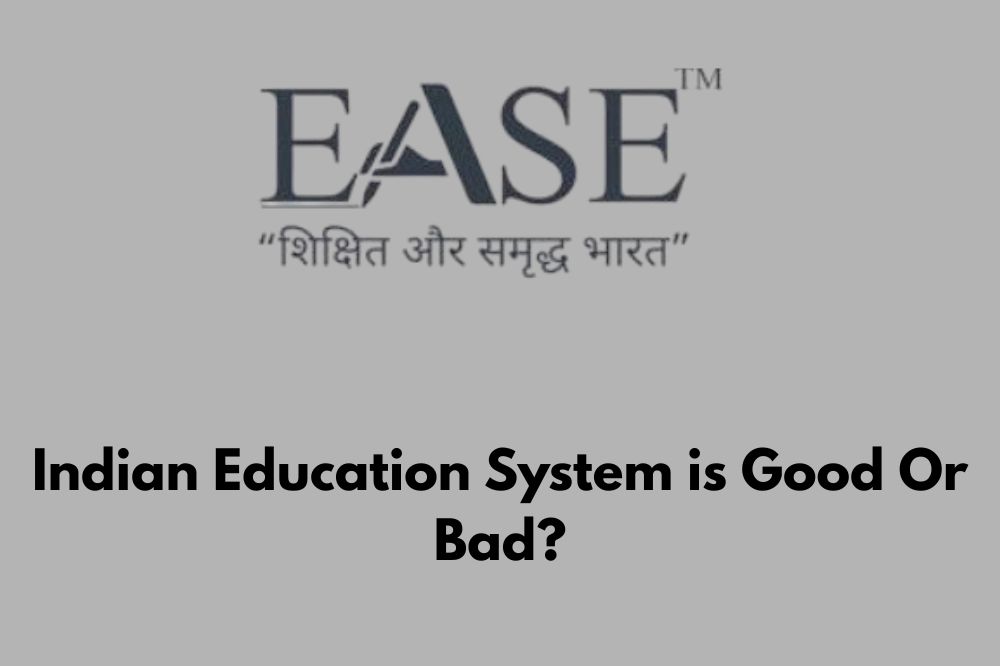
The question “Indian education system is good or bad” is one of the most searched and debated topics among students, parents, and educators across India. With over 1.5 million schools and a legacy that spans ancient Gurukuls to modern digital classrooms, the Indian education system has both remarkable strengths and serious challenges. In this blog, EaseEdu—India’s trusted school growth partner—offers a detailed analysis to help you understand whether the Indian education system is truly serving today’s learners or needs urgent reform. A Brief History of Indian Education India’s education roots trace back to the Gurukul system, where learning was holistic, nature-based, and deeply personal. The British introduced a more formal, exam-driven structure in the 19th century, emphasizing English, math, and science. Post-independence, India expanded access to education through government schools, national boards, and higher education institutions. Today, India has: Over 1.5 million schools More than 33,000 colleges Top-tier institutions like IITs, IIMs, and AIIMS A growing focus on digital learning and NEP 2020 reforms Strengths of the Indian Education System 1. Global Academic Reputation Indian students consistently excel in STEM fields, winning global scholarships and placements in top universities. 2. Competitive Exams Build Rigor Exams like JEE, NEET, UPSC, and Olympiads push students to master subjects deeply and prepare for high-stakes careers. 3. Affordable Public Education Government schools and colleges offer low-cost education, making learning accessible to millions. 4. Diverse Curriculum Choices Students can choose between CBSE, ICSE, IB, and state boards, each with unique strengths. 5. Strong Teacher-Student Culture Respect for teachers and structured discipline still form the backbone of Indian classrooms. Weaknesses of the Indian Education System 1. Rote Learning Over Critical Thinking Many schools still prioritize memorization over creativity, problem-solving, and real-world application. 2. Exam Pressure and Mental Health High competition leads to stress, anxiety, and burnout among students—especially in Classes 10 and 12. 3. Inequality in Access and Quality Urban schools often have better infrastructure and faculty than rural ones, creating a gap in learning outcomes. 4. Lack of Practical Skills Students graduate with theoretical knowledge but limited exposure to hands-on learning, internships, or life skills. 5. Limited Focus on Arts and Vocational Training Creative fields and vocational education are often sidelined, despite growing demand in modern careers. Indian Education System is Good Or Bad? The Indian education system is not inherently bad—but it needs urgent modernization. With reforms like NEP 2020, digital classrooms, and skill-based learning, the system is evolving. However, challenges like exam-centric culture, inequality, and outdated pedagogy still persist. EaseEdu believes that school growth depends on innovation, inclusivity, and emotional intelligence—not just marks and ranks. How to Learn Sanskrit FAQs – Indian Education System is Good Or Bad? Q1. Is the Indian education system outdated? 👉 In parts, yes. Many schools still follow old methods. But reforms like NEP 2020 aim to modernize learning. Q2. Why is there so much exam pressure in India? 👉 Competitive exams decide college admissions and careers, making marks a high-stakes issue for students and families. Q3. Are Indian students globally competitive? 👉 Absolutely. Indian students excel in STEM, coding, medicine, and research worldwide. Q4. What are the biggest challenges in Indian schools? 👉 Rote learning, lack of infrastructure in rural areas, and limited focus on creativity and mental health. Q5. How can schools improve under EaseEdu’s guidance? 👉 By adopting smart classrooms, teacher training, emotional wellness programs, and personalized learning strategies. Final Thoughts from EaseEdu India’s education system is a work in progress. It has produced brilliant minds—but also left many behind. As a school growth partner, EaseEdu supports institutions in building future-ready classrooms that nurture curiosity, confidence, and compassion. Let’s move beyond marks. Let’s build minds.
How to Learn Sanskrit | By EaseEdu
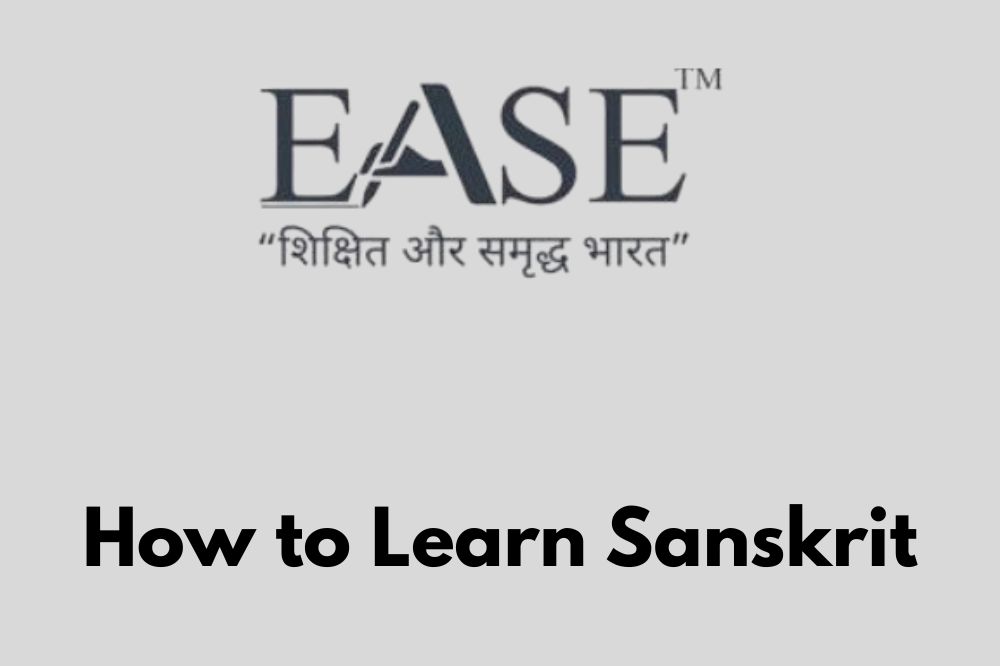
How to learn Sanskrit? Sanskrit is the root of many Indian and Indo-European languages. It’s the language of the Vedas, Bhagavad Gita, Ayurveda, Yoga, and countless classical texts. Learning Sanskrit improves memory, sharpens grammar skills, and deepens cultural and spiritual understanding. Benefits of Learning Sanskrit: Boosts cognitive and linguistic skills Unlocks ancient scriptures and literature Enhances spiritual practices like mantra chanting and meditation Improves pronunciation and phonetic awareness Supports academic excellence in Hindi, grammar, and philosophy Stage 1: Foundation – Get Comfortable with the Basics Duration: 2–4 weeks Learn the Devanagari Script Master vowels (स्वर) and consonants (व्यंजन) Practice writing daily using apps like Write It! Sanskrit or Duolingo Use flashcards for letters and sounds Master Pronunciation Sanskrit is phonetically precise—each sound has a fixed articulation point Use audio tools and YouTube channels like Learn Sanskrit with Kaushik Practice chanting basic shlokas for clarity Build Basic Vocabulary Start with numbers, colors, family terms, animals, and body parts Use flashcards (Anki, Quizlet) and label items around your home in Sanskrit Stage 2: Grammar & Structure – Build the Core Duration: 2–3 months Understand Sanskrit Grammar Learn 8 cases (विभक्ति), 3 genders, and 3 numbers (एकवचन, द्विवचन, बहुवचन) Study verb conjugations (लकार) in present, past, and future tenses Understand sentence structure: Subject–Object–Verb (SOV) Class 8th Sanskrit Chapter 4 Question Answer Recommended Books Introduction to Sanskrit by Thomas Egenes (Vol 1 & 2) The Cambridge Introduction to Sanskrit by Antonia Ruppel Free PDFs from Samskrita Bharati Practice Exercises Translate simple sentences Identify noun forms and verb roots Use online platforms like easeedu and youtube etc. Stage 3: Application – Start Reading and Speaking Duration: 3–6 months Read Simple Sanskrit Texts Start with Hitopadesha, Panchatantra, and Bhagavad Gita Read one shloka a day and write its meaning Speak Sanskrit Join online or local Sanskrit speaking groups Watch Sanskrit news (AIR Sanskrit Radio) Practice daily conversations: greetings, questions, and answers Write in Sanskrit Maintain a Sanskrit diary Translate short Hindi/English paragraphs Compose simple shlokas or prayers Stage 4: Mastery – Dive into Literature and Scriptures Duration: Ongoing Read Classical Texts Vedas, Upanishads, Mahabharata, Ramayana Study Panini’s Ashtadhyayi for advanced grammar Integrate with Spiritual Practice Chant mantras with correct pronunciation Understand meanings of stotras and bhajans Use Sanskrit in yoga and meditation sessions Tools & Resources to Learn Sanskrit Tool/Platform Use Case Duolingo / Write It! Script & vocabulary practice LearnSanskrit.org Grammar & sentence building Samskrita Bharati PDFs, books, speaking groups YouTube Channels Pronunciation & listening Anki / Quizlet Flashcards for revision AIR Sanskrit Radio Listening & immersion Class 12 Hindi Chapter 1 Question Answer Tips for Success : How to learn sanskrit? Practice daily—even 15 minutes helps Use both traditional books and modern apps Speak aloud and record yourself Join a Sanskrit WhatsApp or Telegram group Learn with a friend or tutor for motivation EaseEdu’s Sanskrit Learning Support At EaseEdu, we simplify Sanskrit for school students, competitive exam aspirants, and spiritual learners. Our content includes: Class-wise NCERT Sanskrit solutions Grammar worksheets and MCQs Shloka meanings and pronunciation guides Instagram reels and carousels for Sanskrit tips YouTube Shorts on Sanskrit basics
